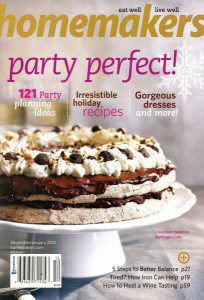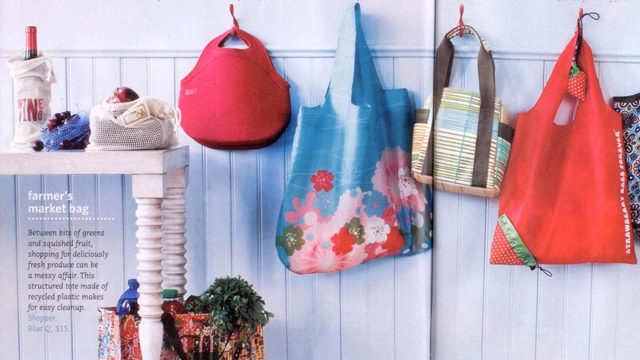A Toast to Homemakers
Homemakers magazine folds after 45 years of food, fashion, and feisty women.
On the evening of November 16, 2011, right around 6:30 p.m., a group of 10 women—editors, former co-workers, and friends—gathered at Sally Armstrong’s condo at Yonge and St. Clair streets in Toronto, in honour of what was once seen as just a “little book of recipes”; one that brought them all together once and has kept them together ever since.
“Typical of them—we were really a team—everyone brought something,” Armstrong says, laughing. “First of all, I prepared—I’d invited them for dinner! But they came tumbling through the door; with wine and presents, and stories—and that’s the best part. And we all shared these stories.”
When Armstrong received an urgent message in late October to contact Homemakers publisher Lynn Chambers, she was slightly perplexed. Chambers was set to make an announcement later that day about the magazine. But Armstrong, a founding editor at Canadian Living, had been editor-in-chief of Homemakers from 1988 to ‘99, and had hardly seen the magazine since leaving to pursue her master’s in women, health, and human rights.
“It didn’t occur to me she was telling me the magazine was going to close,” says Armstrong. “Because why would she want to tell me first?”
“Then I got an email from one of the editors who worked with me, who now lives in Ohio, Jennifer Elliott, saying, ‘I just heard the news that Homemakers is closing.’ And I really heard it first from Jennifer Elliott.”
“And then the screen just filled up with my fabulous old staff,” Armstrong says, laughing. “All of them just, ‘Oh my god! Did you hear? Did you hear?’ And reading their messages, I thought, you know, we really did something together. It was 10 years ago, but we did something together that I’m really proud of.”
That “something” was the legacy of Homemakers as the thinking woman’s magazine, something that started shortly after its launch in 1966 as an in-store giveaway, when Jane Gale Hughes took over as editor-in-chief. Both Hughes and Armstrong brought a dynamic blend of food, fashion, and lifestyle service for married, educated women aged 25 to 54, together with harder-hitting stories involving international, political, and social issues that were relevant to women.
“It was Homemakers magazine that started the campaign to drive with your lights on,” says Armstrong. “It was Homemakers that did the first Mothers Against Drunk Driving campaign.”
But since its 2003 super-digest-sized relaunch, and then a major editorial repositioning of the TC Transcontinental publication in 2009, Homemakers became less of a maverick in its own genre, let alone its publishing company.
Still, in her 2006 anniversary letter, reflecting on Homemakers’ 40th birthday, editor-in-chief Kathy Ullyot, like Armstrong, seemed proud of the groundbreaking content the magazine had always prided itself on: “The magazine born at an awkward time grew into a magazine that could have existed at no other: one that serves up revolution along with recipes, that tells the story of Canadian women’s evolution through a unique amalgam of their public and private lives.”
So, why the decision to fold the magazine?
Jocelyn Laurence, a freelance editor and writer, started a regular column for Homemakers in 2005, but had been freelancing for the magazine for almost 20 years. “You know, it’s a tricky business!” she says. “Keeping a magazine going is extremely expensive, whatever kind of magazine it is. I’m sure [the publishers] were just looking at the bottom line.”
And it was those expenses that resulted in the budget cuts that brought Jessica Ross from the role of executive editor to acting editor in August 2011, mere months before the magazine’s closure. “Through budget cuts, our staff size reduced, so that’s why I moved into the senior role,” explains Ross.
But the common thread among most of the Homemakers editors and publishers—as well as its readership—seems to be their loyalty, to each other, and to the magazine. And Ross, like her predecessors, takes pride in how she directed it.
“Homemakers was a terrific brand, and a fabulous audience to write for. Just a really wonderful group of readers—very loyal, very dedicated, very engaged in the content. And I think that we’re all really proud of the repositioning through which we took Homemakers in 2009. It was a move away from some of the historical positioning of the magazine, with respect to some of the long-form features and so forth, but it certainly reflected what the readers wanted.”
But despite a thriving readership of more than 1.4 million and a circulation of more than 300,000, the shift away from its more revolutionary content may have been the cause of Homemakers’ demise. Publishers found it too difficult to maintain a health and fitness brand not very different from their other titles, and saw profit in exploring new territory.
New territory like Juice, Transcontinental’s new media brand (created in conjunction with Loblaws) that launches in April. The multi-platform project will bring healthy living content to Canadians, including a full-size print magazine published six times a year.
Many of the former editors were surprised to hear about the new project.
“Talk about getting into bed with the advertisers!” says Armstrong with a laugh. She believes that relationships in this industry are key, and that like any family, there should be a healthy balance of friction, respect, and admiration.
And the women who worked for Homemakers were just like the audience they wrote for. At least, that’s how they felt about each other.
Jocelyn Laurence and Kathy Ullyot met twice a year for breakfast at the Luna Café, just west of Ossington Street, close to Laurence’s home, to plan her next few columns—and to indulge in some terrific eggs and toast.
“Kathy was very funny and very charming, and I can be funny and charming if I put my mind to it,” Laurence jokes. “So we talked about the ideas that I had, but out of those ideas came other discussions about life.”
Cheryl Embrett, a former senior editor at Homemakers, was part of, as Armstrong called them, her “best team,” and was there for Armstrong’s dinner of salmon, salad, and roasted potatoes on that November evening; she even brought a cake with “Homemakers 1966-2011” written on it—a small tribute to that “feisty magazine.”
“We all felt that we had met some of the most important people in our lives during our time at Homemakers,” says Embrett. “We had always been a tight-knit little group and had lots of fun together, and that evening was no exception,” she says. “Lots of stories, lots of wine, lots of laughs.”
As she struggles to remember the speech she gave that night, Armstrong promises no regrets. “People used to chuckle about this little magazine with these fabulous recipes—” she says, “and turn the page and someone was telling you how to change the world.”
“But I feel really lucky, and when those bright, charming, clever women poured into my little condo the other night, I thought, ‘Well, aren’t you just the best?’”


















I have been doing some research in regards to Jane Gale Hughes wondering where she is now or if she is still alive.
She is mentioned in this article but it sounds as though she was not part of the get together.
I had heard she had gone to England but the trail is cold.
Do you have any idea as to her whereabouts?
She was a friend of my sisters back in the Fifties in High school in Saskatoon.
Gladi McMurtry